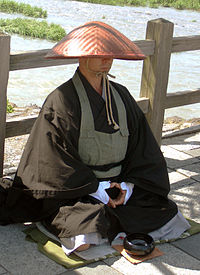Talk:Rinzai school
| This It is of interest to the following WikiProjects: | |||||||||||||||||||||||||||||||||||
| |||||||||||||||||||||||||||||||||||
Untitled
[edit]I took a picture of a (probably) begging Rinzai monk by Oigawa, Arashiyama, [{Kyoto]], if somebody working on this page feels like it could add something to the article, please use it.
I personally know the monk in the picture, he is not a Rinzai but Soto monk. You can judge from his hat and hand gear (soto style).Sendaba 13:23, 6 June 2007 (UTC)
Mackan 13:55, 21 May 2006 (UTC)
Although "Wikipedia is Not a Directory", WP:EL does state that "adding a certain number of relevant external links is of valuable service to our readers". The current article has no space for examples beyond the main temples in Japan, and this feels unbalanced. Some form of See Also or External Links section is needed. A Rinzai temple category, usable in a See Also section. would help navigate extant Wikipedia entries. Rgrant 19:46, 23 May 2006 (UTC)
Suggested move from "Rinzai school" to "Linji school"
[edit]To refer to the origin of the Zen teachings from China. Tktru (talk) 02:24, 18 November 2009 (UTC)
- Rinzai is the most commonly used name to for the school -Pollinosisss (talk) 02:56, 18 November 2009 (UTC)
While the official Rinzai/Ōbaku school website (both Japanese and English editions) is clear that there are 14 branches of Zen, plus Ōbaku, one other temple is sometimes listed: Kōshō-ji (興聖寺, founded by Koō Enni 虚応円耳 in 1603). This is not listed on the official Rinzai/Ōbaku school page, but is listed on Japanese Wikipedia (ja:大本山寺院一覧 “List of head temples”, ja:臨済宗 “Rinzai school”, and ja:興聖寺 (京都市)). The temple certainly exists – it’s on Horikawa street, west side, just north of Kami Goryō-mae street, in Japanese 堀川通 上御陵前上ル 西側 (neighboring streets are Kurama-guchi 鞍馬口通 to the north and Tera-no-uchi 寺之内 to the south; major streets are Kita-Ōji 北大路 to the north and Imadegawa 今出川 to the south); it takes up most of the block (surrounded by normal buildings) and it has a major gate, which you can see on Google maps.
There doesn’t appear to be an official website, and the temple is not open for tourism, but is open for zazen (sitting meditation), so it isn’t mentioned often in tourist information. There’s not much about the temple on the web – it’s a common temple name, and indeed there’s also one in Uji (south Kyoto). One note is this link on the city website: 上京区の史蹟百選,区民誇りの木/興聖寺,ケヤキ (100 Selected Historic Sites of Kamigyō ward, Ward Citizen’s Pride Trees/Kōshō-ji, Keyaki).
Anyway, it’s not clear why this temple isn’t mentioned as a head temple, though it is a bit weird – it’s much younger than the others (by a few centuries), and is an offshoot of Shōkoku-ji (broke off from it at some point). I don’t know if it’s being considered as part of Shōkoku-ji, or if it has been merged/absorbed/reconciled into another branch, or not considered part of Rinzai, or otherwise ignored.
For reference, I’m mentioning it here, and noted it as of this edit, but I don’t suggest otherwise highlighting it (continue to list 14 schools of Rinzai), due to obscurity.
Please add any further information you may find!
- —Nils von Barth (nbarth) (talk) 15:39, 16 August 2012 (UTC)
Hakuin and the Meiji-period
[edit]When did Hakuin's Zen become really influential? Probably during the Meiji-period; at the end of the Tokugawa, Hakuin's line had almost become extinct (Michael Mohr, Hakuin. In: Buddhist Spirirtuality II: Later China, Korea, Japan).





